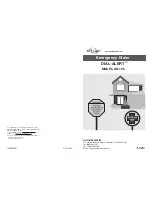
2-8
Cisco Unified Wireless IP Phone 7921G Administration Guide for Cisco Unified Communications Manager Release 7.0
OL-15985-01
Chapter 2 Overview of the VoIP Wireless Network
Components of the VoIP Wireless Network
Table 2-3
Supported Networking Protocols
Networking Protocol
Purpose
Usage Notes
Cisco Discovery
Protocol (CDP)
Device-discovery protocol that runs
on all Cisco-manufactured
equipment.
Using CDP, a device can advertise its
existence to other devices and
receive information about other
devices in the network.
Cisco Unified IP Phones use CDP to
communicate information such as
auxiliary VLAN ID, per-port power
management details, and QoS
configuration information with the
Cisco Catalyst switch.
Dynamic Host
Configuration Protocol
(DHCP)
Dynamically allocates and assigns an
IP address to network devices.
DHCP enables an IP phone to
connect to the network and become
operational without the administrator
assigning an IP address or
configuring additional network
parameters.
DHCP is enabled by default. If
disabled, you must manually
configure the IP address, subnet
mask, gateway, and an TFTP server
on each phone locally.
Use DHCP custom option 150. With
this method, you configure the TFTP
server IP address as the option value.
For additional supported DHCP
configurations, refer to Cisco
Unified Communications Manager
System Guide.
IP
Messaging protocol that addresses
and sends packets across the
network.
To communicate using IP, network
devices must have an assigned IP
address, subnet, and gateway.
IP addresses, subnet, and gateway
identifications are automatically
assigned if you are using the Cisco
Unified IP Phone with DHCP. If you
are not using DHCP, you must
manually assign these properties to
each phone locally.
Real-Time Control
Protocol (RTCP)
Used with the RTP protocol to
provide control over the transporting
of real-time data, such as interactive
voice and video, over data networks.
Cisco Unified IP Phones use the
RTCP protocol to allow monitoring
of the data delivery and minimal
control and identification
functionality.
RTP
Standard for transporting real-time
data, such as interactive voice and
video, over data networks.
Cisco Unified IP Phones use the RTP
protocol to send and receive
real-time voice traffic from other
phones and gateways.
SCCP
Uses Cisco-proprietary messages to
communicate between IP devices and
Cisco Unified Communications
Manager.
Cisco Unified IP Phones use SCCP
protocol for VoIP call signaling and
enhanced features such as Message
Waiting Indication (MWI).
















































